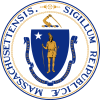| Elections in Massachusetts |
|---|
 |
|
|
Only eight of the 14 Massachusetts incumbents were re-elected.
Massachusetts redistricted between the 3rd and 4th Congress, dividing itself into 14 districts. The 12th-14th districts were in the District of Maine (the modern state of Maine). A majority was required for election. Additional ballots were required in five districts due to the majority requirement not being met on the first ballot.
| District | Incumbent | This race | |||
|---|---|---|---|---|---|
| Member | Party | First elected | Results | Candidates | |
| Massachusetts 1 ("1st western") |
Theodore Sedgwick Redistricted from the 2nd district |
Pro-Administration | 1789 | Incumbent re-elected to a new party. Federalist gain. |
|
| Massachusetts 2 ("2nd western") |
William Lyman | Anti-Administration | 1792 | Incumbent re-elected to a new party. Democratic-Republican gain. |
|
| Massachusetts 3 ("3rd western") |
None (district created) | New seat. New member elected. Federalist gain. |
| ||
| Massachusetts 4 ("4th western") |
Dwight Foster Redistricted from the 2nd district |
Pro-Administration | 1792 | Incumbent re-elected to a new party. Federalist gain. |
|
| Massachusetts 5 ("1st southern") |
Peleg Coffin Jr. Redistricted from the 3rd district |
Pro-Administration | 1792 | Incumbent lost re-election. New member elected. Democratic-Republican gain. |
|
| Massachusetts 6 ("2nd southern") |
None (district created) | New seat. New member elected. Federalist gain. |
| ||
| Massachusetts 7 ("3rd southern") |
David Cobb Redistricted from the at-large seat |
Pro-Administration | 1792 | Incumbent lost re-election. New member elected. Federalist gain. |
First ballot (November 3, 1794):
Second ballot (January 17, 1795):
Third ballot (March 23, 1795):
Fourth ballot (June 1, 1795):
|
| Massachusetts 8 ("1st middle") |
Fisher Ames Redistricted from the 1st district |
Pro-Administration | 1788 | Incumbent re-elected to a new party. Federalist gain. |
|
| Massachusetts 9 ("2nd middle") |
Samuel Dexter Redistricted from the 1st district |
Pro-Administration | 1792 | Incumbent lost re-election. New member elected. Democratic-Republican gain. A petition by various citizens of Massachusetts contested the election. The Committee on Elections ruled in the winner's favor and added "that the attempt to deprive him of his seat was rather the act of malevolence than a desire to promote the public good." On January 25, 1797, these words were stricken out and expressions of compliment to the member were substituted, and the report was agreed to.[1] |
First ballot (November 3, 1794):
Second ballot (January 17, 1795):
Third ballot (March 23, 1795):
|
| Massachusetts 10 ("3rd middle") |
Benjamin Goodhue Redistricted from the 1st district |
Pro-Administration | 1789 | Incumbent re-elected to a new party. Federalist gain. |
|
| Samuel Holten Redistricted from the 1st district |
Anti-Administration | 1792 | Incumbent lost re-election in a redistricting contest. Federalist loss. | ||
| Massachusetts 11 ("4th middle") |
None (district created) | New seat. New member elected. Federalist gain. |
First ballot (November 3, 1794):
Second ballot (January 17, 1795):
Third ballot (March 23, 1795):
| ||
| Massachusetts 12 ("1st eastern, District of Maine") |
Henry Dearborn Redistricted from the 4th district |
Anti-Administration | 1792 | Incumbent re-elected to a new party. Democratic-Republican gain. |
|
| Massachusetts 13 ("2nd eastern, District of Maine") |
Peleg Wadsworth Redistricted from the 4th district |
Pro-Administration | 1792 | Incumbent re-elected to a new party. Federalist gain. |
First ballot (November 3, 1794):
Second ballot (January 17, 1795):
|
| Massachusetts 14 ("3rd eastern, District of Maine") |
George Thatcher Redistricted from the 4th district |
Pro-Administration | 1788 | Incumbent re-elected to a new party. Federalist gain. |
First ballot (November 3, 1794):
Second ballot (January 17, 1795):
|
Notes[edit]
- ^ Changed parties
References[edit]
- ^ "Fourth Congress (membership roster)" (PDF). Archived from the original (PDF) on December 13, 2012. Retrieved December 7, 2012.